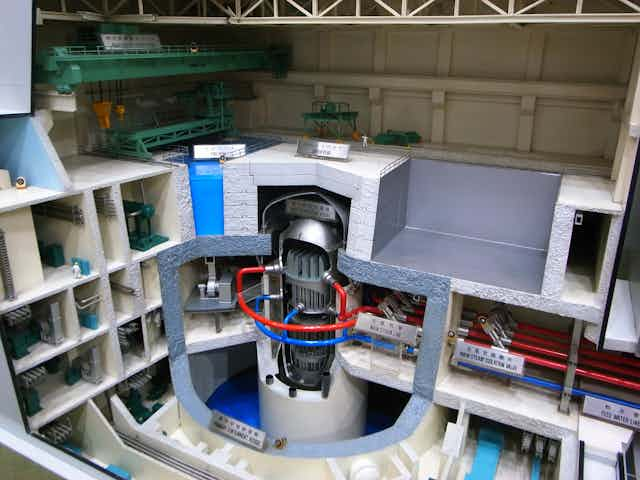Britain appears to finally be on the way to building its first new nuclear power station for 20 years. The chancellor of the exchequer, George Osborne, recently announced a £2 billion loan guarantee linked to the development of the Hinkley Point C power plant, signalling that the final decision to build cannot be far behind. But the plans from French firm EDF have drawn criticism from an array of experts and commentators for being too expensive and relying on an as yet unproven technology that is already being redesigned.
Although the basic principles of nuclear energy are relatively simple, the specific designs of different reactors can vary considerably. The two other companies hoping to build new nuclear plants in the UK, for example, each favour alternatives to EDF’s model. So are we in danger of backing the wrong technology with the current plans for Hinkley Point?
Nuclear reactors generate heat from uranium using a reaction known as fission. This is a process where atomic nuclei split into two fragments, releasing energy in the form of heat. Fission of one atom also releases several neutrons that can spark the same process in neighbouring atoms, leading to a chain reaction throughout the uranium fuel within the reactor core. The chain reaction can be slowed or stopped by inserting control rods into the core to absorb the excess neutrons.
The heat from the reaction is used to create steam, which generates electricity via a turbine. The heat is carried away from the core by a coolant substance, which can also be used as a moderator to slow down the neutrons and increase the chances that they induce fission in other fuel atoms (although some designs use separate moderators).
Overdue, over-budget, over-engineered
The reactor EDF wants to use at Hinkley Point C is a type of pressurised water reactor (PWR) that uses water as both the moderator and coolant. The specific design is known as a European pressurised reactor (EPR) and evolved from earlier French models with innovations such as a concrete-ceramic core catcher to prevent the molten core of the reactor escaping in the case of a meltdown. If built, it will deliver 3.2GW of electrical power, roughly equivalent to 7% of the UK’s electricity.
Power stations featuring this enhanced EPR design are being built in France, Finland and China, but none are yet online and the first two are billions of pounds over budget and years overdue. The Chinese projects are only delayed by around two years, perhaps due to experience gained in the European projects.
The predicted cost of Hinkley Point C has steadily risen from £14bn to £24.5bn and has steadily risen from earlier estimates of £16bn. The complexity of the project is enormous, due to what is believed to be by many to be an over-engineered design. There are also reported issues regarding the manufacture of the reactor pressure vessel for the EPR associated with anomalies in the composition of the steel.

Simpler reactor
EDF has admitted that Hinkley Point C will not start operating in 2023 as originally predicted. As a result, the first new nuclear plant to come online in the UK may actually be an entirely different type: the advanced boiling water reactor (ABWR), a proven Japanese design from Hitachi-GE that has been used in nuclear power stations since the 1990s.
This reactor is simpler because the water is allowed to boil in the reactor creating steam directly. In PWRs on the other hand, two stages are required to create the steam and the water in the core is maintained at pressure to prevent boiling. The ABWR is also self-compensating. This means it can maintain a stable temperature simply through normal operation. The hotter it gets, the more steam it produces. This reduces the amount of neutrons produced and so the reaction slows down, diminishing the amount of heat again.
On top of this, the ABWR has advantages from a manufacturing point of view. It has a modular design (it is build in sections assembled in factories rather than in one big piece) and so its construction is more straightforward and therefore cheaper. This means the electricity price the government will need to guarantee to the plant’s operator Horizon is likely to be lower than that of the 92.5p/MWh agreed with EDF for Hinkley Point C.
New generation
Looking further into the future, the NuGen proposal, backed by Toshiba, to bring the Westinghouse AP1000 design to the UK is another promising prospect. This advanced passive 1GW reactor is actually a PWR but is highly simplified compared to the EPR with far fewer components and so far fewer things that could wrong. It also employs a large amount of passive safety features that work even without an external power source. In this instance natural processes such as gravity-induced flow and convection are used to drive the circulation of cooling.
Unfortunately, the rather blinkered focus of the government on delivering the Hinkley Point project without recognising what is coming in the near future is a significant point of weakness for UK nuclear energy policy. An approach that gave greater recognition to the potential of other designs could avoid future embarrassment, as well as saving money for the taxpayer and energy bill payer.

